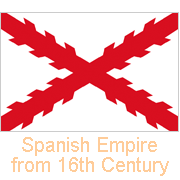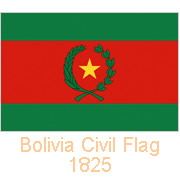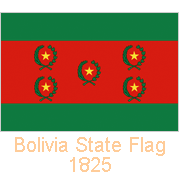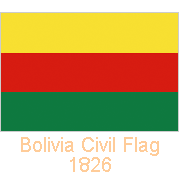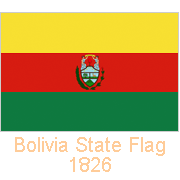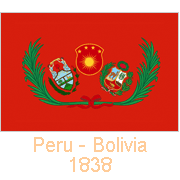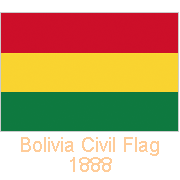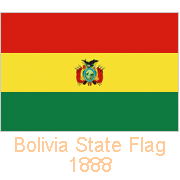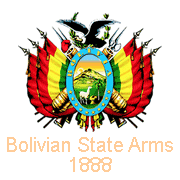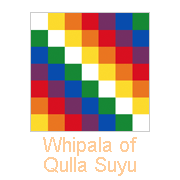Flags from Bolivia
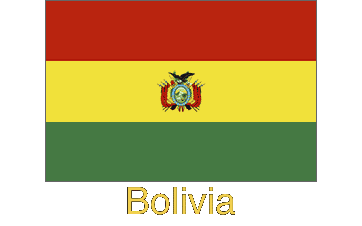
A Flag history of Bolivia
Bolivia declared its independence from Spain in 1825 and initially, on 17 August 1825, adopted a flag consisting of a band of dark red (in Spanish “punzo”) flanked by two green stripes; The dark red field had five gold stars, flanked by laurels and tree branches, standing for each Department: Charcas or Potosí, La Paz, Cochabamba, Santa Cruz and Antofagasta. Less than a year later, on 25 July 1826, a simple yellow - red - green flag was adopted; yellow and green were the colours of Colombia and her liberator Simón Bolívar, who also liberated Bolivia: the country was named after him. This flag was used until 14 July 1888, when the national colours were fixed: red-yellow-green.
you may then send it as a postcard if you wish.
In 1838 General Santa Cruz created the short-lived Peruvian - Bolivian Confederation, consisting of Bolivia, North Peru, and South Peru. Its flag was a red field with the three shields of the constituent states in the centre united by interlaced garlands. However, a year later, in 1839, General Santa Cruz was overthrown, and the Confederation was disbanded.
The present flag was adopted on 31 October 1851 and confirmed on 14 July 1888 when the sequence of the colours was officially fixed. Red symbolises the courage of Bolivian soldiers, yellow or gold the mineral wealth and green the country’s fertility. A coat of arms had been adopted in 1825 and was changed slightly and made official in 1888. It consists of an oval shield with Mount Potosí, an alpaca, a breadfruit tree, and a wheatsheaf, with a forest and a house in the middle distance. The upper border of the oval bears the country’s name in gold and the lower blue edge has nine five-pointed stars representing the departments of the nation. Behind this are two crossed cannon barrels, six Bolivian flags, four rifles, a Phrygian cap of liberty, an Inca battle axe and a laurel wreath; perched on the oval shield is an Andean condor. This emblem is placed on the central yellow stripe of the State flag.
The square “Whipala” flag with its seven rows of seven rainbow colours dates back to the days of the Inca Empire (Tawantinsuyu in the Quechua language). During those days, there were four different arrangements for each of the provinces that made up the Empire, specified by the colour of the longest diagonal line. Qulla Suyu, the region encompassing Aymara areas of present-day Peru, Bolivia and some areas in northern Argentina and Chile, was represented by the white diagonal. The Spanish had banned the Whipala as it had become a symbol of resistance to their rule and was adopted by indigenous rights movements in modern times. It became very prominent at public events, like the Pujllay Festival. The Qulla Suyu Wiphala became the standard used in the campaign that culminated in the election of Evo Morales, an Aymara, who on 22 January 2006 became the first non-European Bolivian president since the Spanish conquest. Since 5 August 2009, the Qulla Suyu Wiphala must be flown on all public and private buildings together with the red-yellow-green national tricolour.


